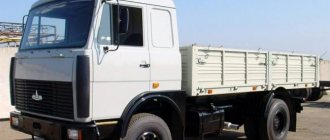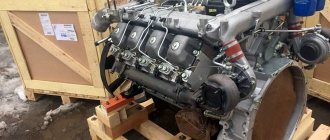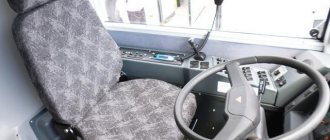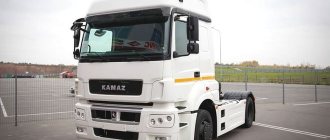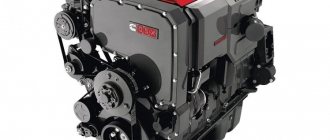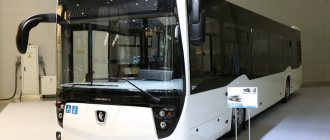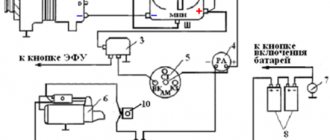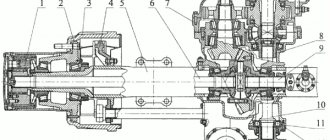NefAZ Electric bus KamAZ-6282. Photo Transport Center
Neftekamsk Automobile Plant is an automobile manufacturing company whose assembly line produces an extensive range of equipment. Founded in 1972, the enterprise is now part of the structure of KamAZ PJSC. Since December 2000, the plant's model range has also included passenger transport . NefAZ produces and sells general and special purpose buses . Transport differs in technical characteristics. It is the variety of parameters of NefAZ buses that were produced earlier, rolling off the assembly line and being sold now that the article is devoted to.
Factory regulations and standards for the manufacture of models
The NefAZ company/brand is widely known in Russia and abroad. Consumers associate buses of the brand with reliability and safety . Transport embodies good operational and consumer properties , an optimal ratio of quality and price. The plant has a clearly defined operating strategy - the production of a wide model line of superstructures on universal chassis. At the beginning of its work on the production of buses, the plant actively collaborated with leading foreign enterprises , which helped to modernize the characteristics of the models, improve the technological processes of the vehicle production process, reach a new level in the field of design and make the Russian auto industry competitive in the international market.
Bus NefAZ-3299. Photo UralSpetsTrans
Today, the company continues to actively cooperate with world market leaders , which allows us to offer equipment with a wide range of advantages. The quality and characteristics of the buses are presented at a high level, since the company is guided in its activities by the following principles and standards:
- Maximum satisfaction of customer needs by providing high-quality and affordable equipment in a wide range, which ensures the possibility of purchasing machines by customers of any category.
- Use of innovative technologies that guarantee safe operation.
- Introduction of advanced functionality, which allows you to use one model to solve a wide range of problems.
- Convenience of ownership and subsequent maintenance is ensured by rare repairs.
Cities and corporations: how KAMAZ conquers bus fleets
– While residents of the listed cities will get acquainted with the new type of public transport, our designers have prepared the next electric bus model for release in 2022. What are its differences?
– It has improved batteries with a larger capacity, helping to increase the autonomous range of the electric bus from 50 to 80 kilometers. The transition from a diesel heater to only the electric part is in line with the global trend of increasing environmental friendliness of transport, and we are also moving in this vector. In addition, we are switching to the climate system of one of the international leaders, Thermo King. We have reduced acoustic noise in the driver's area by changing the power steering system. And, importantly, our new electric bus meets the international safety standard ISO 26262, which in the future opens markets for us in foreign countries.
“HOPE OUR COOPERATION WITH THE PEOPLE IS NOT OVER…”
– Speaking about the environmental friendliness of vehicles, it’s probably worth mentioning the transfer of vehicle fleets to gas-powered buses? To which cities are they planned to be delivered in the near future?
– St. Petersburg is extensively updating its passenger transport fleet with environmentally friendly gas buses. Last year, we handed over to the largest road carrier in St. Petersburg, State Unitary Enterprise Passazhiravtotrans, a bus powered by compressed natural gas (CNG) for test operation. It received positive feedback and in August we signed a contract for the supply of 20 of these buses. A liquefied natural gas (LNG) bus was also handed over to one of the largest private carriers in St. Petersburg, JSC Third Park. As a result, they signed a contract with him for the supply of 303 LNG and 61 CNG buses as part of the transport reform, which starts in 2022. Among other large supplies of gas buses, I would like to mention Novosibirsk. Won the tender. She ordered 100 buses from us, 50 of which we will deliver this year and 50 in the second quarter of 2022.
– So the practice of test operation is also applied to buses?
– Yes, test operation has confirmed its effectiveness for promoting buses on the market, and we are actively using it. As I already noted, two gas buses were transferred to St. Petersburg, and in November we will transfer a new LNG model to Passazhiravtotrans. Also this year, our buses were successfully tested in Ufa and Murmansk. Based on the results of the operation of the new semi-low-floor CNG bus, we entered into a contract and are already completing the delivery of 100 such buses for Bashkortostan. Among the immediate plans is the transfer of a gas bus for operation in Penza.
– KAMAZ is actively working on the “Safe and High-Quality Roads” project. To which cities were our buses delivered as part of the national project?
– Last year we delivered 155 buses to Kazan, Kemerovo and Yekaterinburg, and at the expense of this year’s budget we sold 210 buses to Perm, Novosibirsk, Kemerovo, Cherepovets, Kazan, Yekaterinburg. They occupy 69% of the total volume of bus deliveries under the BKAD project. In addition, we are now working on the delivery of another 20 buses for Nizhnekamsk.
External parameters of KamAZ models
dimensions
Length
The manufacturer specializes in the production of buses of small and large capacity classes. The length of the body of the structures averages 7700 and 12500 mm. Shift models, in accordance with the length of the body, can be classified as small-class transport. However, if we take into account the capacity, which for NefAZ trucks in most cases does not exceed 10 passengers, then this is a particularly small class of equipment. Therefore, when analyzing parameters, emphasis is placed on general-purpose models.
Bus NefAZ-5299 on the roads of Yekaterinburg. Photo Wikipedia
Previously, the model range included particularly large (articulated) variants and medium-sized models, which included the NefAZ-Daimler-42997, produced in a single prototype. Therefore, there is little information about this option. There is no information about specimens of the second type; in the second case, the parameters are 18500 mm. The body length of the popular model NefAZ-5299 is 11800 mm.
Width
The company produces general and special purpose vehicles. Dimensions of special equipment in most cases vary according to the width of the body. But the Neftekamsk Automobile Plant produces vehicles whose design width is always 2500 or 2550 mm. This is due to the fact that platform and school buses are created on the basis of standard urban and suburban models. The width of shift vehicles, including the popular NefAZ-4208-11-13 model, is 2500 mm.
Shift bus NefAZ-4208-11-13. Photo UralSpetsTrans
Metal weight
The weight of the metal is not a parameter that is provided to potential buyers in the specifications or that can be found in the public domain. But for calculation it is possible to use a formula that will allow you to find out the approximate parameter. To do this, from the weight of the metal of a specific bus model, it is necessary to subtract 30% from the total weight of the model, which accounts for the weight of non-metallic elements and components. The technically permissible weight of the urban diesel model Bravis-11 is 9500 kg. Thus, the calculations look like this: 9500 – 2850 = 6650 kg.
City bus Bravis-11. Photo NefAZ
How much does the model weigh or mass in general?
In the technical specifications, you can find such parameters as curb and technically permissible (gross) weight . The average values for these parameters differ depending on body length and capacity. As a result, for small-class passenger transport the indicators are on average 6000 and 9000 kg, for large ones - 11000 and 18000, for especially large ones - 16500 and 26500. Indicators for the modification of the large class NefAZ-5299-20-15 are equal to 10170 and 18000 kg .
Cabin capacity
Interior capacity is a determining characteristic when choosing a bus, regardless of the client category. Capacity directly affects other parameters and is also directly related to individual properties.
Number of seats
NefAZ small-class buses, operating on urban and suburban routes, allow an average of 25 passengers to comfortably sit in a seated position, with a total capacity of 45 people . The number of seats and the total capacity of large models differs depending on the purpose: urban - 25 and 75 , suburban - 45 and 85 , tourist/intercity - 50, transportation of standing passengers is not provided.
Intercity bus NefAZ-5299-17-52. Photo NefAZ
But often intercity technology is used to cover short distances, so standing passengers can also be accommodated. Particularly large models designed for city travel are equipped with about 50 seats; in total, the buses can accommodate up to 150 passengers. The intercity bus NefAZ-5299-17-52 is equipped with 44 seats , the total capacity is 71 passengers.
Seating diagram
The layout/scheme of the cabin depends not so much on passenger capacity, but on the purpose of the model. The interior of urban transport is distinguished by wide aisles and large storage areas; seats can be located in the direction of travel or against the direction of travel, as well as with the backrest against the wall of the body. Suburban, tourist, intercity, school models are equipped with seats located clearly in the direction of travel , in pairs on each side of a narrow (compared to city transport) aisle. The interior of apron models is equipped with a small number of seats. Due to the short duration of trips around the airport, most of the equipment space is occupied by storage areas . The interior diagram of the NefAZ-5299-11-52 commuter bus is presented below.
Interior diagram of the NefAZ-5299-11-52 commuter bus. Photo NefAZ
Equipment inside
The basic configuration of the bus includes a significant amount of equipment and functions. Most manufacturers and suppliers, including NefAZ, as well as its official dealers, provide this information in the technical characteristics of the model. The list of parameters differs depending on the purpose of the model. Not all functions are specific to the interior configuration.
The greatest number of characteristics is inherent in school buses, which must meet a high level of safety and reliability. The basic equipment of NefAZ-5299-40-52 includes: ERA-GLONASS emergency call system; panoramic windshield (glued in); continuous glazing of doors; electronic route indicator; information complex Iskra (a set of LED displays in the amount of 3 pieces).
Driver's seat
Access to the driver's seat is provided either through a separate door or through the first passenger door. The driver's cabin is separated (most often in the interior of urban NefAZ models) by a partition in which a hinged door is made . Thanks to the presence of a partition, the driver has no distractions while working. If the partition is closed, then it has a folding window. There is a place in the cabin: a niche and/or a drawer for placing the driver’s personal belongings. The panoramic windshield and large rear-view mirrors provide excellent visibility.
Some models are equipped with pull-down curtains on the windows. The hands-free system is another useful feature. The driver can set a comfortable temperature in the cabin independently thanks to the presence of a separate heater . The driver's seat, which has mechanical adjustments, provides comfort. It is worth noting that not all of the listed functions are included in the models. Buses of previous years were equipped with less equipment. Intercity NefAZ-5299-17-42 has the following functions: heater, glove box, panoramic windshield, no partition.
Instrument/control panel
The driver's cabin is equipped with devices for remote control of lighting, heating and ventilation of the bus interior, radio equipment, control lamps, the keys and switches of which are located on the panel. The number, order and layout of switches differ depending on the model and configuration of the bus. But the dashboard is in any case accessible and understandable to the driver. The following is a video that allows you to see the control panel of the NefAZ-5299-10-33 .
Wheels
A mandatory parameter of technical characteristics is the tire size. Choosing the right tires that can bear the heavy load and ensure a safe ride is an important process. NefAZ buses of various types are equipped with 235/75R17.5 and 215/75R17.5 tires (small models); 285/70R19.5 and 275/70 R22.5 (large and extra large). The popular model of the electric bus (the first mass-produced in Russia) KamAZ-6282, created through the efforts of the NefAZ and KamAZ companies, is suitable for tires measuring 275/70R22.5.
City electric bus KamAZ-6282. Photo NefAZ
KAMAZ has revealed the characteristics of its waterbus, which will hit the streets of Moscow in 2022
At the COMTRANS-2021 exhibition, KAMAZ presented its first waterbus - a passenger bus powered by hydrogen fuel. Water buses will hit the streets of Moscow to test the technology in practice next year. Russia is still lagging behind other countries in the issue of passenger transport using hydrogen, but it intends to keep its finger on the pulse.
Image source: KAMAZ
According to Deloitte, in 2022, the largest number of waterbuses traveled around China - over 2 thousand units. The EU was in second place with 76 waterbuses on its lines. There were 35 hydrogen-powered passenger buses in the United States and another 18 in Japan. How many water buses will run around Moscow today is not specified. But if the process goes ahead, the assembly of the vehicles can be done on site - at the Sokolniki Car Repair and Construction Plant, where KAMAZ electric buses are already being assembled today.
A prototype of the KAMAZ-6290 hydrogen fuel bus was created on the basis of the KAMAZ-6282 electric bus, which is logical, since both have the same power plant - electric. The power of the hydrogen power plant reaches 45 kW, which, with a weight of 19 tons and a maximum speed of 80 km/h, will allow one to travel up to 250 km or three times further than on a purely battery platform.
Image source: KAMAZ
The passenger capacity of KAMAZ-6290 is 80 people, of which 33 are seated. There are also places for passengers with limited mobility. The body is steel and plastic. Six hydrogen cylinders are installed on the roof of the bus, which in the event of a leak will prevent explosive gas from accumulating in the cabin.
“In addition, the waterbus is equipped with a modern braking system with a hill hold function, the ability to block movement when the doors are open, and a brake pad wear monitoring sensor. In case of emergency, braking can be accomplished using a traction motor,” the press release explains.
Image source: KAMAZ
At the same time, the Concept for the Development of Hydrogen Energy in Russia does not take into account hydrogen as a fuel resource in the near future. “Currently, there is no global market for hydrogen as an energy resource,” says the Concept signed in August by Russian Prime Minister Mikhail Mishustin. The country produces quite a lot of hydrogen, but it is mainly used to support technical processes in the petrochemical industry. On this basis, it is quite possible to create an experimental base for studying transport using hydrogen plants, and increasing the scale will be technically simple.
Internal parameters
Engine
The heart of any vehicle is the engine. There are several criteria according to which it is possible to list the main characteristics of the power unit.
Firstly, this is the model, brand, manufacturer, country of manufacture. NefAZ trucks are equipped with engines from modern leading world companies from different countries: Cummins (USA), Weichai (PRC), Yuchai (PRC), Mercedes-Benz (Germany). Shift models are equipped with Russian KamAZ engines. Some modifications of the NefAZ-5299 of previous years were also equipped with domestic units. VDL series models are powered by DAF brand engines (Netherlands).
Tourist bus VDL-NefAZ-52999. Photo UralSpetsTrans
Secondly, depending on the production period of the buses, the unit models comply with the environmental standards of Euro-2, Euro-3, Euro-4 and Euro-5.
Thirdly, NefAZ trucks are equipped with diesel and gas units , the power, displacement and maximum torque of which vary within fairly significant limits. But the most popular volume and power parameters can be noted: 4; 6.7; 10.85; and power 140; 240-270 hp
Fourthly, the engine can be located in the front and rear parts of the body.
Fifthly, the arrangement of cylinders (4, 6 or 8 pieces) can be in-line (R) or V-shaped (V). NefAZ-5299-30-22 was equipped with a Cummins ISBe 250.30 diesel engine with a power of 250 hp. and volume 5.9 l.
Cooling system
Most models are equipped with a liquid engine cooling system, which is connected (connected) to the main heating system. modification has a liquid system , which is part of the bus heating system.
Gearbox/gearbox
Neftekamsk plant buses are equipped with gearboxes of the following brands: KamAZ, ZF, Fast Gear, Voith, Allison. Thus, the equipment is equipped with reliable, safe, durable mechanisms that meet current quality standards. Mechanical and automatic transmissions of general and more special-purpose models have 5 or 6 steps, shift gears have 9-12. As an example, we give the characteristics of the gearbox of the NefAZ-52291 model: six-speed manual ZF 6S 1600.
Bus NefAZ-52991-11. Photo UralSpetsTrans
Transmission device
The transmission of modern buses, including the NefAZ brand, includes the following elements:
- The clutch of models in most cases is single-disc dry.
- Checkpoint.
- Cardan and final drives.
- Differential.
- Half shafts
Depending on the type of drive, there are four-wheel drive, front-wheel drive and rear-wheel drive. The popular rotational bus NefAZ-42111 has a 4x4 wheel arrangement, the all-wheel drive model has increased cross-country ability.
Rotational bus NefAZ-42111-24. Photo NefAZ
Brake system
Which one is used?
the Knorr-Bremse, Wabco brands . Wheel brakes: disc or drum. The NefAZ-5299-11-56 service brake system is dual-circuit pneumatic with ABS.
NefAZ-5299-11-56, suburb, gas. Photo Transport Center
Scheme
There are no diagrams of the bus braking system in the public domain, so it is not possible to provide information. If any of the visitors has this information, please provide it in the comments to the article.
Fuel
use diesel, gas and electric energy as fuel The NefAZ-5299-40-51 modification with the Mercedes-Benz M 906 LAG engine operates on compressed methane natural gas.
Fuel tank volume
The volume of the fuel tank is calculated in liters or in the form of the number of gas cylinders multiplied by their capacity. The parameters for small buses are on average 125 (diesel models) and 300 (for gas ones), for large ones - 200 and 1000, for shift buses that operate only on diesel fuel - 400. The volume of the fuel tank of the urban model NefAZ-5299-40-52 is 200 liters.
Low-floor restyled NefAZ-5299-40-52. Photo Transport Center
Petrol
The model line does not (and previously did not) contain gasoline models.
Methane
The popularity of gas-powered vehicles is not accidental; the models are distinguished by significant fuel economy, high performance, and meet all international environmental standards, which is important for the modern urban environment. The NefAZ-5299-30-51 model, equipped with a Mercedes-Benz M906 LAG.EEV/1 gas engine, operates on methane.
What is the average consumption per 100 km
The average fuel consumption of small buses is about 20, large – 30, shift buses – 35 liters. Diesel consumption for NefAZ-5299-11-52 is 45 liters.
Suburban bus NefAZ-5299-11-52. Photo NefAZ
Power reserve
Cruising range is an indicator that is calculated by dividing the tank volume by fuel consumption. Let's carry out calculations for the popular model NefAZ-5299: 250: 24 = 10.416. The indicator must also be multiplied by 100 km, since fuel consumption is precisely for this distance. The total is 1041.6 km.
KAMAZ Compass and GAZ Valdai on Comtrans: Russian and Chinese are brothers forever?
About a year ago, GAZ introduced the new Valdai - with a cabin from the Chinese Photon. And now KAMAZ has presented its medium-duty truck - the new Compass also received a Chinese cab, only from a JAC brand truck. We got acquainted with this new product at the Comtrans exhibition, and also found out how Valdai was doing after almost a year of sales.
It's funny, but small external changes in the KAMAZ style with a large grille and blocks of round lighting equipment have transformed the familiar Jak - it looks, if not modern, then at least not so Chinese. What can not be said about the interior decoration of the cabin: the country of origin is clearly felt in the quality of materials and the fit of interior elements, and its design reflects the middle age of the JAC N-series model itself.
There are also some gags common to many Chinese trucks on our market - information plates translated from the native language into Russian. For example, a sticker placed on the tank asks to fill up with the correct diesel fuel “in different environments”, and driver advice on the sun visor suggests “stopping by” at a gas station to “charge diesel fuel”...
The frame, bridges and main units here, by the way, are also Chinese. The engine is a Cummins ISF diesel engine with a volume of 3.8 liters and a power of 154 hp, familiar to many of our service technicians. The gearbox is a six-speed Fast Gear brand.
The total weight of the presented vehicle, called Compass 9, with an isothermal booth and a refrigeration unit is 9.5 tons with a load capacity of 3.3 tons. These Compasses will be the first to go on sale - before the end of this year. A little later, Compass 12 will appear with a gross weight of 11.99 tons, “babies” - a five-tonne vehicle, and even a 3.5-tonne car that can be driven with a category “B” license.
At first, while the model is testing the market, all components for it will come from China and be assembled at the main plant in Naberezhnye Chelny. Later, localization is planned - up to complete.
Prices are so far known only for Compass 9. A flatbed truck with a minimum of options will cost a little less than three million rubles, but the device presented at the exhibition with an isothermal booth and a refrigerator costs more than five million.
Well, what about Valdai? According to Gazovites, sales are going on, but not as actively as originally planned. Many people are still afraid of a car with a modern, but still Chinese, cabin - they have to explain that the chassis is all ours...
At the exhibition, Valdai stood with new superstructures. The first is a flatbed truck with a Palfinger crane installation. It has a maximum boom reach of 7.5 meters and a load capacity of up to 3.2 tons. The cost of this version has not yet been finalized.
The interior of the Valdaev cabin looks more modern than that of the Compass
The second car is a tow truck. A platform of 8.2 meters is installed on the chassis, and vehicles weighing up to 2.35 tons can be driven here. In this case, the winch is designed for a force of 4.1 tons. If for a regular Valdai they are now asking about 2.6 million, then such a car will cost about 800 thousand more.
And this Valdai became a tow truck
As for the prospects, in the future it is planned to release a heavier version of the Valdai with a total weight of 7.5 tons - this will increase the carrying capacity by almost 800 kg. Such a truck will be supplied with a Cummins engine of increased power, and the chassis will also be slightly modified. We should expect this version next year.
Differences in parameters for gasoline models and gas models?
| Parameter | On diesel | On methane |
| Fuel consumption | Diesel consumption is approximately 4 times greater than gas consumption | |
| Degree of influence on components, mechanisms | The treated gas does not leave carbon deposits on the elements of the power system, which minimizes the likelihood of breakdowns | |
| Equipment design | Cylinders located in a separate compartment on the roof provide visual differences from diesel models | |
| Environmental friendliness | Methane evaporates completely (even at low temperatures), leaving no harmful combustion products | |
| Maintenance and repair costs | Modern engines are complex technical mechanisms with several of the most vulnerable elements. Therefore, their repairs are carried out more often and require the expenditure of more significant funds. | |
| Price | Lower cost | |
| Load capacity | Reduced load capacity due to installation of gas equipment | |
New NefAZ bus in Moscow: from a passenger’s point of view
Quite recently, exclusively as a passenger, I traveled around the Moscow region on a new semi-low-floor LiAZ commuter bus. And in the comments to that material, readers were reminded that not so long ago new buses, NefAZ low-floor buses, also began to operate in Moscow. I also rode this bus as a passenger - and now I’m ready to talk about my impressions.
The fact that the LiAZs, which have already become traditional on Moscow streets, will be joined by NefAZs (this is a subsidiary brand of KAMAZ) became known at the end of 2022, when the first contract for the supply of 596 such buses was signed. But, as it turned out, he was not the only one: last year the Moscow authorities signed two more contracts, information about which is available on the government procurement website. Based on these data, it can be argued that soon there will be as many as 1,449 such buses in the capital, 76 of which are training, with additional cabins for instructors. The total cost of all three contracts is almost 19 billion rubles - not weak!
The NefAZs themselves are analogues of the model with the index 5299-40-52 - with exterior and interior design modified to meet the capital’s requirements. The technical stuffing is standard for cars of this class - a 250-horsepower Cummins and a ZF automatic transmission. The total passenger capacity is almost one hundred people.
The main difference between a bus and an electric bus from the outside is the visually lower roof due to the missing bulwarks
The body here is actually the same as that of Moscow electric buses of the same brand - similar front and rear masks and only the absence of additional bulwarks on the roof indicates that this is a bus. The similarity with electric buses, by the way, brings confusion to the ranks of passengers: when she saw that I was photographing the bus, an elderly woman at the bus stop commented that it was “also an electric bus, but with a motor.” We laughed.
On the back is the emblem of the KAMAZ parent company
I go inside, put the “troika” on the terminal and look around - no, the interior layout here is not the same as that of its electric counterpart. The main difference is the huge “engine house” in the left rear corner, with three seats next to it. At first I got a job on one of them, but I didn’t stay there for long: there is much more noise and especially vibration from the engine here than, say, in similar places in the low-floor LiAZ. I went to the middle of the cabin and later watched as other passengers did the same - no one could stand more than one stop in the “gallery”.
However, there were no other annoying sounds in the cabin - the new upholstery is still “silent”. And the ride of the bus is smooth, largely thanks to the front independent suspension. Here it is the same as that of an electric bus or, for example, a UTTZ trolleybus, which I met not so long ago. As for the attributes of comfort, USB chargers for gadgets on the handrails have become a familiar part of the capital’s transport, as well as a large storage area with space for a wheelchair and a guide dog.
But the layout solutions surprised me. For example, if in the cabin of an electric bus there are as many as eight seats on a low floor, then here there are only five of them - and one is generally single. There are also five seats on the podium between the front and central doors - the central one is installed transversely between the other four. There are more seats in the electric bus, and they are arranged much more rationally.
USB chargers on the handrail - symbols of time
As for the general impression, the new bus fits well into the capital’s realities. It’s noisy, of course, but overall it’s quite a competitor to the already familiar low-floor LiAZs. But…
Trudyaga-LiAZ has long become familiar to Moscow passengers - for several years now such buses have been running on the traditional trolleybus route “B”
That day I traveled along one of the capital’s routes on another bus - it’s called Mercedes Conecto. A hundred of these Turkish-made vehicles were delivered to the capital at the end of 2014 - literally at the end of the time when state carriers could still purchase imported rolling stock.
And when you get on this bus, you can’t even tell that it has spent almost six years on the capital’s streets. It’s quiet inside, nothing rattles or rattles, and the quality and thoughtfulness of the interior are simply top notch. And it remains unattainable for the products of domestic bus manufacturers to this day.
Where can I buy
In conclusion, it should be said that NefAZ buses are distinguished by a variety of characteristics that allow not only classification, but also selection of a model with optimal parameters. Meeting customer specifications ensures efficient and cost-effective operation. Therefore, familiarizing yourself with and studying the characteristics of equipment is an important preliminary stage in purchasing equipment. It is possible to purchase NefAZ buses from the manufacturer’s employees and from suppliers; the companies are collected in a separate section of our website. The companies presented on our website also provide ]rental[/anchor], leasing and re-equipment of buses.
